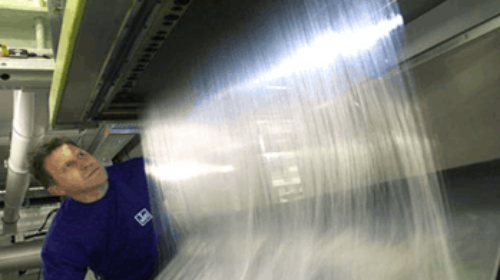
Plastic molder utilizes dry ice cleaning to achieve continuously high product quality and improved durability of tools
THE SITUATION
Werner Breitschädel GmbH WB (WB GmbH) of Bad Endorf, Germany manufactures small plastic parts with a high degree of complexity for companies in the fields of electrical, railway and measuring technology, the aviation industry, mechanical engineering and, in some cases, the automotive industry.
“A workpiece with a length of 200mm is already a very large part for us,” observes Werner Breitschädel, who has run the family business for 30 years.
The tolerance requirements are correspondingly high and are often in hundredths of a millimeter. The tool and molds for these precision components are also manufactured at WB GmbH. The filigree injection molds are designed and built by experienced employees in close cooperation with the customers using latest CAD and CAM technology.
“We usually build the molds for our customers, then conclude a loan agreement with them and produce the plastic parts as a service provider,” said Breitschädel. “We guarantee our customers for each manufactured form a minimum quantity of parts.”
THE PROBLEM
Around Around 220 different technical plastics are processed on twelve injection molding machines in a three-shift operation, including long-fiber reinforced thermosets, high-temperature thermoplastics, such as PEEK and fiber-reinforced thermoplastics.
“Many plastic materials are, for example, equipped with fire protection,” explains Günther Hartl, Executive Assistant at WB GmbH. “These additives often cause outgassing. The vapors build a coat on the tool surfaces that affects the quality of the parts. A regular mold cleaning is therefore crucial for a consistently high quality.”
Depending on the plastic used, the molds are cleaned up to once per shift, and after completion of the order. In order to not damage the delicate surfaces and contours of the filigree forms, WB GmbH has always cleaned the molds in an ultrasonic bath. The molds had to be removed from the injection molding machine, disassembled and then reassembled. This traditional cleaning process caused production interruptions of at least four hours and required two employees on average. After cleaning in the ultrasonic bath, there was still some dirt on the surfaces, which had to be manually removed with a fine sanding paper or something similar.
“A minimal amount of substrate was also removed by the abrasive process,” said Hartl. “This, as well as the high time and personnel expenditure, led us to conduct experiments with a dry ice system with pellets a few years ago. However, it was not suitable for our filigree forms.”
THE SOLUTION
At the Fakuma tradeshow, the WB GmbH management team was drawn to the i3 MicroClean. An innovative dry ice cleaning system from Cold Jet. The system works with dry ice (solid form of CO2), which is produced as a by-product in chemical or industrial processes. It is therefore environmentally neutral.
Cold Jet’s dry ice cleaning system uses non-abrasive media in the form of recycled CO2 pellets that won’t damage surfaces or equipment. The combination of dry ice cleaning’s kinetic energy and thermal effects break the connection between the dirt and surface, lifting away contaminants. Unlike blasting with other media, dry ice cleaning does not leave any secondary waste, because the dry ice particles sublimate upon impact – converting from solid to gas. Dry ice cleaning is safe and non-toxic, does not create downstream contamination and reduces or eliminates employee exposure to dangerous chemical cleaning agents.
The i3 MicroClean uses dry ice blocks, which are shaved, using the patented shaved dry ice technology, to produce small, odorless MicroParticles. Compared to conventional dry ice pellets, they form a finer cleaning stream, which can penetrate into the filigree contours and cavities and allow gentle, but at the same time effective treatment of the surfaces which are sensitive to damage. In addition, the noise produced by the i³ MicroClean system is significantly lower than with a pellet dry ice system.
After a successful demo at WB GmbH, they decided to test the device for four weeks.
“In this way we were able to find out the concrete benefits for our company,” said Breitschädel. “During the test phase, we found that the device was easy to use and the employees acceptance was high. A further advantage is the mobility of the mobile dry ice cleaning system. This makes it easy for us to use it in injection molding and mold making process.”
THE RESULTS
The company uses the i³ MicroClean device with several different blast nozzles. The cleaning of flat areas is carried out with a wide blast nozzle with 2.2cm blast width. Hard to remove contamination can be reliably removed with the round blast nozzle. Dirt from undercuts, corners and edges, as well as other areas that are difficult to access, can be cleaned with a 90 degree angled and 360 degree rotatable angle nozzle. A LED light integrated into the ergonomically designed applicator ensures optimum illumination of the areas to be cleaned. The blast pressure and the quantity of ice can be individually adapted to the respective surface and degree of soiling, which ensures the most economical use of compressed air and dry ice.
“Now an employee can clean the molds during production without removal and disassembly,” said Hartl. “We achieve an amazing cleaning effect in only 15 minutes, compared to the earlier four hours. This allows us to also clean more frequently and thereby improve the product quality further. And last but not least we more rarely dismantle the molds, which increases their lifetime.”
In addition to the injection molding shop, the i³ MicroClean is also used in the maintenance department of the tool shop. After all, the company does not dispense the basic cleaning of the molds in the ultrasonic bath despite the dry cleaning process. The disassembled components are pre-cleaned with dry ice, which shortens the ultrasonic cleaning cycles and makes manual abrasive reworking superfluous. This also contributes to increased durability of the molds.
“The i³ MicroClean device has many advantages for us, and so we have recommended it to a fellow company,” remarks Werner Breitschädel.

